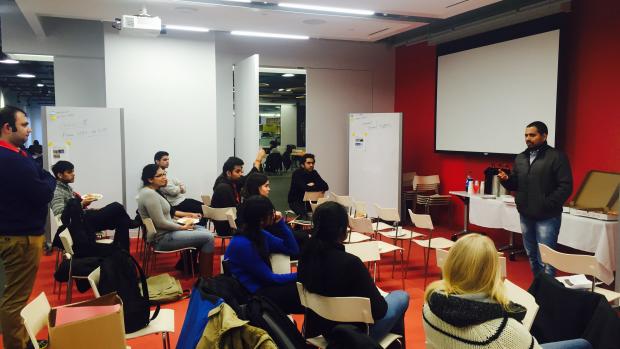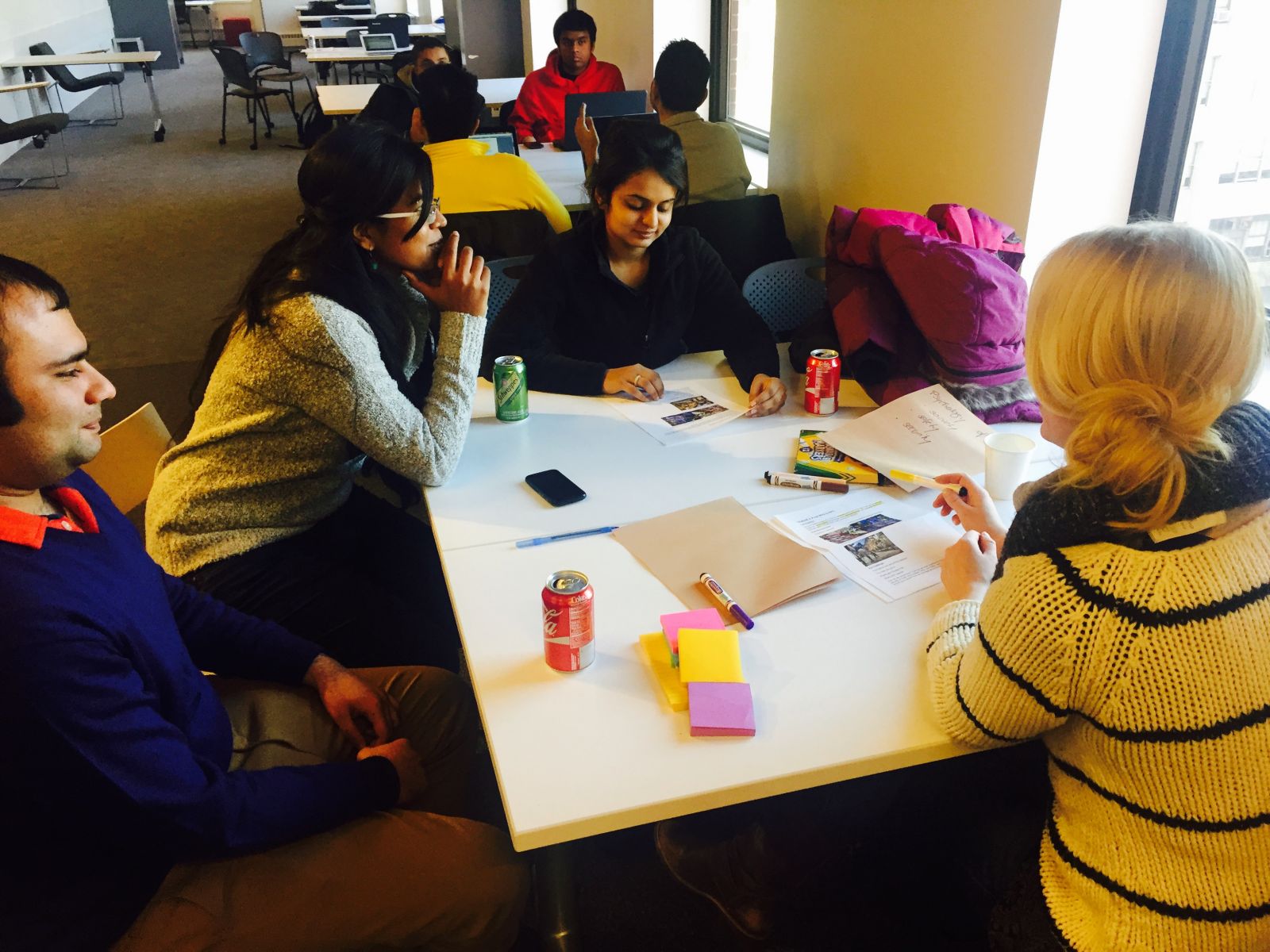Hacking A Way to Safety

On a bitter, cold February day—the coldest day on record in New York City—the Design Tinkering Club at the School of Engineering hosted a hackathon. The event, titled ‘Hack Your Way to Safety’, was designed to bring those who can program apps and those who cannot together to devise ways to improve the safety and security of NYU students using technology. The hackathon was part of the club’s current journey to becoming the NYU chapter for Design for America, a network of student-led studios creating local and social impact through interdisciplinary impact.
Earlier this month, Design Tinkering hosted an ideation workshop at the Greenhouse, led by a DFA Fellow. Participants were invited to brainstorm to develop solutions to increase campus safety, and the hackathon was created to help develop some of the ideas that emerged from this workshop into prototypes that could be tested.
The Design Tinkering Club is a student group that uses human-centered design to develop solutions for social issues. The club had previously organized the Hack Ebola event at NYU that culminated into the creation of SMSanté, a system that uses SMS technology to provide information on the status of an Ebola outbreak in a particular location. SMSante was a winning idea on the OpenIDEO challenge sponsored by USAID and is now running an Indiegogo campaign to pilot their app.
(1).jpg) Another successful concept developed by the club is the Bindi Project, a collaboration with ‘Women for Human Rights’, a Nepalese NGO. The Bindi Project was selected as a winning idea on the OpenIDEO platform and is receiving funding from DFID, the UK agency for international development. The Bindi Project—run by women, for women—seeks to build communities in low-income urban areas by training leaders and connecting women together within the community. The goals are to empower them with valuable information, give them a strong place within their communities, and assist them in gaining their independence through knowledge and jobs. The Bindi Project Web site also offers a toolkit with guidelines on how to start similar projects elsewhere.
Another successful concept developed by the club is the Bindi Project, a collaboration with ‘Women for Human Rights’, a Nepalese NGO. The Bindi Project was selected as a winning idea on the OpenIDEO platform and is receiving funding from DFID, the UK agency for international development. The Bindi Project—run by women, for women—seeks to build communities in low-income urban areas by training leaders and connecting women together within the community. The goals are to empower them with valuable information, give them a strong place within their communities, and assist them in gaining their independence through knowledge and jobs. The Bindi Project Web site also offers a toolkit with guidelines on how to start similar projects elsewhere.
The club’s hackathon event that was held on February 20-21 addressed issues that were much closer to home. It revolved around asking participants to come up with solutions that would improve campus safety. To help jump-start ideas, four “channels”, inspired by the DFA workshop, were created with each representing a category the prototypes could fall into. Channel 1, dubbed “Travel Buddies,” posed the question of how to connect individuals traveling to the same location in order to not only save money in travel costs, but to also alleviate their own fears of traveling alone. Channel 2, “Emergency Response,” was for creating a safe environment through networks of students who live in the same neighborhoods. Channel 3, “From NYU to NYC,” looked for ways to pool NYU’s resources with those of the greater New York area to improve safety in and around NYU campuses. Finally, Channel 4, “From Conversations to Community,” addressed the requirement of a community’s existence in order to begin safety measures on the ground, and looked at how to generate that community in the first place.
This particular hackathon – following a current trend - emphasized the role of non-coding participants. While it can’t be denied that coders are necessary to actually build the apps, those who do not know how to code were also welcomed as community experts able to provide insights. People were encouraged to form teams that were a mix of both coders and non-coders to strike that balance between technical prowess and a wide-focus. “Multidisciplinary teams are crucial to develop creative ideas” said Anne-Laure Fayard, Associate Professor of Management and advisor to the club. She stressed that, “It is important for technical solutions to be successful to understand users’ needs and behaviors as well as context more broadly. Non-technical participants tend to be more empathic of the users.”
Design Tinkering Club, knows that just having good ideas is not enough and that prototyping them is key to have an impact. Hence, they are working hard to assist in taking some of the promising solutions to the prototyping phase – by giving teams access to resources, networks, and some funding such as the Greenhouse Prototyping Grants. “If you really put your back into it, we will help you,” said Nikhil Mirza, one of four students from the Design Tinkering Club who co-hosted the hackathon. Mirza emphasized the need to look outside of singular solutions and to think of how apps will work in inadequate situations—like, for example, when the user is taking the subway and Wi-Fi is scarce. “You also have to factor people into the design.”
"This was my first Hackathon experience and it was amazing. I had the opportunity to know and collaborate with inspiring people from different backgrounds. Besides that, the Hackathon gave me the chance to give back to the society, making the NYU community safer." said Izabela Correa, participant of the Hackathon. “Girl or Boy. No matter who we are. We want to live without fear. So we should come help build a safe world. It’s the need of the hour.” said Deepika, another participant who is building an application for campus safety.
All in all, for the good that could come from taking part in this hackathon, it wasn’t a bad way to spend a couple of chilly days in February. Two ideas are currently being prototyped by 2 teams and hopefully Design Tinkering will soon become the NYU Chapter of Design for America:
 NYU Safe is an Android/iOS app that uses location-based services to notify NYU community members within a mile when a user reports an emergency. It relies on the existence of a community that feels responsible for its members, and thus implies security for individuals. The creators of the app also want it to take it to the next level – from just response to emergency situations, to allowing members to volunteer their homes as ‘safe-zones’ to allow fellow students in their neighborhood know where to go when they feel unsafe. The team is composed of 5 students: Uday Kiran Kollu; Krishna Teja Velagapudi; Deepika Jangra; Izabela Correa and Abhinav Jana
NYU Safe is an Android/iOS app that uses location-based services to notify NYU community members within a mile when a user reports an emergency. It relies on the existence of a community that feels responsible for its members, and thus implies security for individuals. The creators of the app also want it to take it to the next level – from just response to emergency situations, to allowing members to volunteer their homes as ‘safe-zones’ to allow fellow students in their neighborhood know where to go when they feel unsafe. The team is composed of 5 students: Uday Kiran Kollu; Krishna Teja Velagapudi; Deepika Jangra; Izabela Correa and Abhinav Jana
Travel Buddy focuses on the worries that students have about travelling back home after a late night of work. Many students have late night classes and work till late at the libraries. At the same time, most students live in neighborhoods that are at least 30 minutes away, and aren’t necessarily the safest. Thus, this idea aims to connect students who are nearby, are travelling to the same neighborhood at similar times, to not only reduce the feeling of insecurity when travelling alone, but also to save money on cabs or taxi services. The team is composed of four students: Kunal Relia; Naimesh Narasinga; Pradhyog and Siddharth.
The sentiment of the penultimate looms over Design Tinkering at this moment. Hanging in the balance is not only the testing and implementation of these two ideas, but they also have to tie all their projects together to make it through the final round of the Design For America application process. Though they began with the broader question of women’s empowerment, the salience of safety and security to liberate individuals has become their rallying principle. They are currently working on creating a video that would document their fascinating journey – from discovery and design to deployment. Fittingly enough, those steps don’t only apply to the creation of technological solutions, but also to the creation of a strong and dedicated team.
To learn more about the hackathon and the prototypes of NYUSafe and Travel Buddy, contact one of the organizers (Ashwin Gopi, Nikhil Mirza, Abhinav Jana and Siddanth Rameshchander) at designtinkering@gmail.com.





